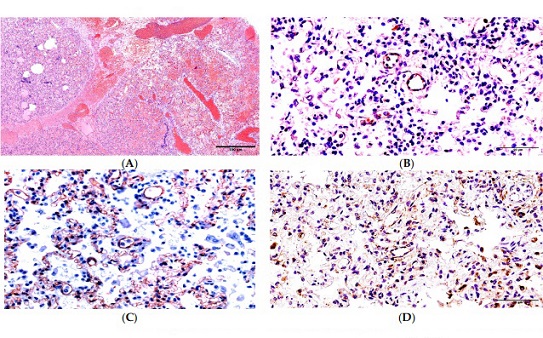COVID-19 News: Russian Autopsy Study Of Children Who Died From SARS-CoV-2 Infections Shows That COVID-19 Is An “Angiocentric Disease”!
Nikhil Prasad Fact checked by:Thailand Medical News Team Nov 27, 2023 1 year, 4 months, 3 weeks, 2 days, 15 hours, 8 minutes ago
COVID-19 News: In the post-pandemic era, as the global community strives to regain a semblance of normalcy, the impact of COVID-19 on children continues to be a subject of intense scrutiny. Despite the World Health Organization's declaration of the pandemic's conclusion, a lingering shadow persists in the form of ongoing cases, particularly those affecting children. This
COVID-19 News report delves into an illuminating autopsy study conducted by the Saint Petersburg State Pediatric Medical University in Russia, offering profound insights into the intricate and distinctive pathological features of COVID-19 in pediatric patients.
 Changes in the lungs in Patient 1. (A) Widened vessels, hemorrhages, dystelectasis, and serous-hemorrhagic exudate in the alveoli lumina. H&E under ×100 magnification. (B) SARS-CoV2 nucleocapsid expression on the walls of the micro-vessels and in interalveolar septa under ×400 magnification. (C) CD31 immunostaining, the irregular capillary network, and the desquamation of some endotheliocytes under ×400 magnification. (D) The widespread expression of apoptosis marker CD95 on the walls of micro-vessels and the interalveolar septa under ×400 magnification.
Study Objectives and Rationale
Changes in the lungs in Patient 1. (A) Widened vessels, hemorrhages, dystelectasis, and serous-hemorrhagic exudate in the alveoli lumina. H&E under ×100 magnification. (B) SARS-CoV2 nucleocapsid expression on the walls of the micro-vessels and in interalveolar septa under ×400 magnification. (C) CD31 immunostaining, the irregular capillary network, and the desquamation of some endotheliocytes under ×400 magnification. (D) The widespread expression of apoptosis marker CD95 on the walls of micro-vessels and the interalveolar septa under ×400 magnification.
Study Objectives and Rationale
The overarching goal of this study is to bridge a critical gap in our comprehension of the disease's dynamics in children by meticulously examining the morphological features of lung involvement and evaluating the intricate interactions between the virus and its host. The research focuses on a cohort of three pediatric cases, each representing different stages of the disease, presenting a nuanced narrative through a multifaceted analysis involving histopathological and immunohistochemical investigations.
Clinical Landscape of Pediatric COVID-19
While the bulk of COVID-19 cases manifests in adults, the pediatric demographic is not immune to the virus's impact. Approximately 3.6% of identified cases involve children, and a fraction of these necessitate intensive care. Notably, children with underlying health conditions, particularly those with oncological diseases, face an elevated risk of severe outcomes. The dearth of comprehensive studies elucidating the pathological morphology of COVID-19 in children has impeded our understanding of the disease's trajectory in this vulnerable population.
Detailed Autopsy Findings
The study meticulously scrutinizes three pediatric cases with disease durations of 5, 20, and 50 days, respectively. Patient 1, with a brief 5-day course, exhibits early signs of diffuse alveolar damage, characterized by bronchial epithelium detachment and prevalent interalveolar hypostasis. In Patient 2, with a 20-day duration, there is a pronounced decrease in lung airiness, accompanied by dense protein aggregates in alveoli and widespread inflammatory infiltration. Patient 3, spanning a protracted 50 days, displays distinct manifestations of diffuse alveolar damage with a notable reduction in the expression of viral antigens and apoptosis markers.
&nb
sp;
Insights into Virus-Host Interactions
Immunohistochemical investigations unravel compelling details about the virus-host interactions. A distinctive finding is the acute expression of SARS-CoV-2 antigens in the bronchial epithelium and blood vessels, particularly conspicuous in patients with shorter disease durations. Intriguingly, the study identifies a substantial viral load in the upper respiratory passages and a persistent viral expression in severe cases, underscoring the pivotal role of epithelial cells as primary replication centers.
Endothelial Involvement: A Key Factor
A conspicuous commonality across all cases is the pronounced damage inflicted upon endothelial cells in vessels of varying sizes. This study posits the vascular factor as a linchpin in COVID-19 pathogenesis, designating the virus as an "angiocentric disease." The primary and predominant targeting of endothelial cells by various pathogenic factors is substantiated by the presence of SARS-CoV-2 antigens (nucleocapsid protein) resulting from the virus's penetration and replication within these cells. The subsequent destruction of infected endothelial cells due to induced apoptosis emerges as a central element leading to microcirculation disorder, disseminated intravascular coagulation syndrome (DIC-syndrome), multiple organ dysfunction syndrome (MODS), and ultimately, death.
Role of Apoptosis: Unraveling Mechanisms of Pathogenesis
A significant revelation from the study is the identification of apoptosis as a consequential outcome of virus-host interactions. Patient 2, in particular, exhibits a substantial number of apoptosis corpuscles throughout the respiratory system, suggesting that apoptosis plays a pivotal role in COVID-19-related deaths in children. The study sheds light on the intricate interplay between the SARS-CoV-2 neocapsid protein, apoptosis markers like CD95, and apoptosis corpuscles in different lung structures, offering critical insights into the pathogenesis of the disease.
Implications and Future Perspectives
The study's findings not only contribute significantly to our understanding of COVID-19's impact on children but also provide a roadmap for future research endeavors. Recognizing the virus as an angiocentric disease underscores the paramount importance of the endothelium in the disease's progression. The identified vascular factor offers valuable insights for the development of targeted therapies focused on protecting the endothelium, thereby preventing the development of disseminated intravascular coagulation syndrome.
In conclusion, the Russian autopsy study stands as a beacon illuminating the intricate dynamics of COVID-19 in children. The virus's designation as an "angiocentric disease" highlights the central role of the endothelium, and the findings pave the way for the development of innovative therapeutic approaches. The study's comprehensive analysis not only deepens our understanding of infectious diseases but also holds promise for applications in non-infectious conditions, opening new avenues for medical research and intervention.
The study findings were published in the peer reviewed International Journal of Molecular Sciences.
https://www.mdpi.com/1422-0067/24/23/16750
For the latest
COVID-19 News, keep on logging to Thailand Medical News.
